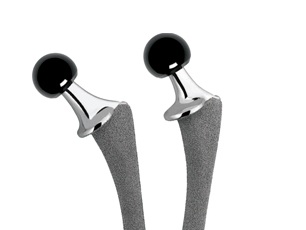


ECHELON revision hip implants are part of a family of femoral stems that address both Primary and Revision indications. With one set of instruments, a variety of stems can be implanted.
ECHELON Revision is designed with the goal of providing long-term, pain-free restoration of joint function and normal hip biomechanics.
The system is composed of cementless and cemented implants with lengths ranging from 190–300 mm, and sizes from 11–22 mm.
Download ECHELON Revision Case Studies (link)
7138-0790: Stem Design and Dislocation After Revision Total Hip Arthroplasty – Barrack, et, al.
Fractures of distally-fixed femoral stems after revision arthroplasty – Busch, et al.
The Role of Proximal Femoral Support in Stress Development within Hip Prostheses – Crowninshield, et al.
Revision hip arthroplasty using an extensively porous coated stem: medium term results- Jayakumar, et al.
HA on Porous Coating
The ECHELON Porous Plus HA prosthesis is a fully porous coated stem. Subsequently, a 50 micron hydroxyapatite layer is then applied onto the porous surface.
Circulotrapezoidal Neck
Provides maximum ROM with minimal impingement, thereby reducing the risk of dislocation and wear. Neck length is increased for restoration of offset.
The 12/14 taper is optimized to avoid impingement on the cup and maximize ROM.
Addressing Proximal Defects
Stems are available with standard collar and 15 mm calcar platforms.
Stem sizes range from 11 mm – 20 mm in 1 mm increments for improved canal fill and fixation. Femoral component offset progressively increases with increasing implant size. Offset ranges from 38 mm – 62 mm depending on the femoral head size chosen.
Simple Instrumentation and Technique
Instrumentation enhances a straightforward surgical technique, which optimizes OR efficiency and reproducible results.
The stem inserter threads into the implant to provide rotational control. A distally slotted, fluted stem generates lower bone strains during insertion than a solid fully coated stem of the same geometry.1
Download ECHELON Revision Design Rationale
1. Suzuki, Yoshihiro, M.D., Renowitzky, Glen, B.S., Lotz, Jeff, Ph.D., Barrack, Robert L., M.D.,Bourne, Robert B., M.D., Rorabeck, Cecil H., M.D., and Ries, Michael D., M.D., Effect of Cementless Femoral Stem Design on Bone Strains and Torsional Stability.
Hip components are indicated for individuals undergoing primary and revision surgery where other treatments or devices have failed in rehabilitating hips damaged as a result of trauma or noninflammatory degenerative joint disease (NIDJD) or any of its composite diagnoses of:
Hip components are also indicated for inflammatory degenerative joint disease including: